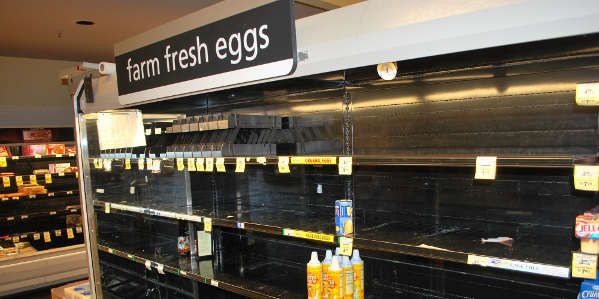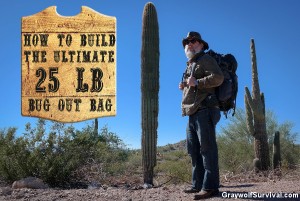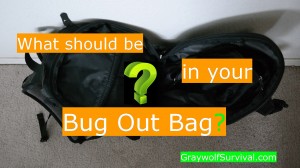 Food is one of the most important considerations in a long-term survival situation. It’s also an important consideration for those in short-term emergencies who want to maintain some semblance of normalcy – especially those who have family.
Food is one of the most important considerations in a long-term survival situation. It’s also an important consideration for those in short-term emergencies who want to maintain some semblance of normalcy – especially those who have family.
If you’re just in the beginning stages of stocking and preparing for emergencies, make sure you figure out have water stored and a way to filter it such as a higher quality microfilter or survival desalinator
, depending on your circumstances. That’s a higher priority than having food.
This post will break down why you need to store food for short- and/or long-term emergencies.
This was going to be a full post on not only why you need to have food available, but the different ways you can make sure you have food for long-term emergencies. Due to feedback I got on my facebook page (love you guys – you know who you are), I broke this HUGE post into several ones. This will allow me to go into more detail on each without you having to come back to read this over several days. Love the idea.
I’ll be following up this article with the subsequent sections I have listed at the end of this article. A few of you said that you’d rather read something all in one sitting, so as I finish each section, I’ll have the topics for the next chapters at the end. Once I write each article, I’ll come back and put the link into the list of topics so you can read them as they’re written instead of having to wait until they’re all done.
I’ll be giving as many direct examples in links as I can to take you to exactly what I’m talking about – or at least some good examples. I’ve gotten some great feedback emails from you guys saying that you like having a concrete example to look at so I’m taking more time to look them up with each post now.
I know that a lot of you that have been following my blog since I started it when I was deployed to Afghanistan are used to me downplaying a lot of the threats that are out there in the world because quite frankly, a lot of it is crap and just used to scare you into clicking the scary title to read the article. The characterization of those threats is out of proportion with the risk and probability of those threats.
Well, I don’t mean to concern you, but your food supply is one of those things that you should be concerned about on some level. Even if you don’t think there’s any chance that society could ever collapse, you should take steps for at least the firly likely events I’ll be talking about. I absolutely think it’s not likely but there are enough possibilities out there that I can’t ignore it.
I’m not saying that you need to build yourself a bunker and stash it with 10 years of food but you absolutely need to do some research on some of the things that could happen and take prudent measures for yourself. This series on food isn’t going to give you everything that you need to know to make that informed decision – but it should give you enough of an idea that you’ll now know some of the threats that you should understand for yourself.
The nice thing is that with some research and some proper planning, even some of the worst things that could happen won’t be all that bad. Also, the worst things that could happen aren’t nearly as likely as the lesser things. It doesn’t really take too much to make sure you’re not only prepared foodwise for those scenarios – you can go on like nothing’s wrong. The added bonus is that some of these solutions will allow you to eat healthier and more delicious food.
If you would like to take the blue pill…
and not know some of the real threats to your food supply, just buy yourself some of this to make sure you have something to cover you in case of a storm or through most disasters or to get an idea of what you like and how you might live with emergency food and wait until the next chapter is published.
But if you choose the red pill…
and want to know about some of these fairly likely as well as not-so-likely-yet-catastrophic events I’m alluding to, read on you beautiful hunk of prepper – read on …
So why are we even talking about emergency food for your home?
In most cases, you’re not going to bug out to a cabin in the woods if something happens. Your life isn’t likely to just go on like normal and then BLAM! – SHTF. You’re MUCH more likely to face something like a short term power outage, area-wide storm, or even temporary martial law due to riots or whatever. In most cases, you’ll be staying home – and rightly so. Bugging out in a disaster situation is one of the most dangerous things you can do.
There are absolutely some reasons that could cause you to have to leave your home: fire, flood, military incursion, alien invasion, whatever. Luckily, they are the exception, and not the rule. Not to say something like that can’t happen – and DEFINITELY I’m not saying you shouldn’t involve something like that in your planning – but you need to understand there are a lot of other things that could happen in the meantime.
As far as food’s concerned though, it doesn’t matter whether you bug out or bug in – you’re gonna need food eventually. It may be true that you can go for a few weeks without eating before you die of starvation, but if you don’t get some food coming in, you increase your likelihood of dying WAY before that from your brain making wrong decisions, grumpiness causing division amongst your group, and your bodies immune system not being able to function as well.
Plus, without calories coming in, it becomes increasingly difficult to do a lot of the important things that you would need to do to have water, shelter, protection, and travel. Get it out of your head that you can go a month without eating. In a real survival situation, you’re not likely to survive if you do.
Plus, I know a lot of you don’t research, learn, and practice things just to ensure that you don’t die if something bad happens. Most of us would like to actually float through bad things like they’re minor inconveniences. If the power goes out in town for several days and you have a generator – who cares? If the city’s water supply becomes temporarily undrinkable for the next couple of months but you have an effective way to filter and purify it – who cares? For those who are prepared, major problems can become minor adjustments to your daily life. For everyone else, they have to endure a lot more stress than they should.
Just-In-Time and the Albertson’s Syndrome
If someone wants to buy or use something that you supply, you have to make sure that you have that product available for them. When you have a temporary increase in demand on that product, you need to increase distribution and then possibly production of it to meet that demand. Unfortunately, you can only increase things so much.
In grocery stores, that increase is felt at first in the logistics chain that moves the food and then trickles back to the farms later on. There’s usually enough flexibility (called elasticity) in the chain to temporarily increase how much is shipped to a particular store or region. This temporary increase ability is called surge capacity.
Basically, if you normally ship 10 tons to a store per week but you have enough trucks that you could divert a couple to increase it to 15 tons due to something like a local Homecoming celebration, you have a surge capacity that you can deal with when things are out of the ordinary.
If ALL the stores in an area that are supplied by those trucks had a temporary increase to 15 tons, there wouldn’t be any trucks you could divert. You’d still be supplying at 10 tons and delivering at 15 tons – until you run out. As grocery stores and shipping companies cut more and more corners to save money, that surge capacity gets closer and closer to normal capacity, not leaving any room for error.
The reason food runs out is that they keep only a few days of food in each store to cut down on their working capital that’s required to buy and store extra food.
If your store room could cut down to half of what it had before, it could buy a smaller store and pay less for utilities for it every month. It also doesn’t have to have as much money invested in food that’s waiting to be purchased – and – it’s less likely to be stuck with food that doesn’t sell, due to normal market fluctuations or new flavors/boxes that people don’t like.
This philosophy and management of keeping lower inventories to closer match demand is called Just-In-Time thinking.
According to many experts and government officials, this Just In Time mentality that makes us run so efficiently when nothing goes wrong, is a threat to us if something serious ever does go wrong.
This Wall Street Journal article (http://online.wsj.com/news/articles/SB113703203939544469) is mainly about what would happen to medical supplies during a pandemic, but it does mention grocery stores as the example of what happens when people hear something bad is coming. They call it the Albertson’s Syndrome:
One significant concern is what Michael Leavitt, the secretary of health and human services, described in an interview as the “Albertson’s syndrome,” referring to the grocery-store chain. At the first sign of panic, all supplies disappear from shelves, something that routinely happens when there is the threat of even a modest storm.
The Grocery Manufacturers Association, which represents food retailers and distributors, estimates that the time it takes for manufacturers and wholesalers to deliver on a retailer’s order has shortened to fewer than four days from nearly eight days in 1999. Respondents to an association survey “are targeting even shorter cycle times of three days,” the survey said. Rick Blasgen, a former ConAgra Inc. executive and chief executive of the Council of Supply Chain Management Professionals, says food retailers and producers “can’t afford just-in-case inventory.”
Has this ever happened? Absolutely. It happens every single year, somewhere around the country. Some years, it happens across a LOT of the country. In some countries, it’s been so bad that they took years to recover (look at Venezuela, Equador, Russia and others back in the Cold War, as well as pretty much any country that’s had a war on its shores).
I’ve broken down a quick, general idea of how each of these could affect you:
- Likelihood – How probable is it that you could be faced with this effect in the next 10 years
- Severity – How much of your food supply would be affected
- Disruption of food supply – How long could you expect to be affected by this occurrence
This is just to give you an idea for the entire category but obviously one problem could lead to other problems and something that you’d think should only take a few days could cascade into years, and something that you’d think might be permanent may be solved by some uber geeks in a few months.
Let’s see some of these examples…
Heavy weather storms
- Likelihood: VERY
- Severity: VERY
- Disruption of food supply: 3-7 days
When even very short-term emergencies such as large weather storms start to move in, grocery stores clear out immediately – such as in August, 2011 when residents of the East coast wiped out all available grocery food as soon as they heard Hurricane Irene was coming.
Even just a winter storm can clear off shelves like they did in Fayetteville, NC and even Dallas, TX, right before the storms came in during the winter of 2013.
There are many, many other cases all around the country and the world every single year where this happens. Here are just a very few examples of that same winter.
Thankfully, things came back to normal in a week or so.
In almost all cases, people usually have several days of food available to them in their home to get through something like this. Even in college, I had a couple boxes of spaghetti noodles and a case of ramen noodles available, although the keg would have emptied pretty quickly. Hopefully people didn’t wait until the last minute and run out after the storms had already started. You can survive for a while without food but you may not last very long out in the middle of one of these storms.
Those millions of people who weren’t prepared for these storms had a hard time when they hit, and for some time afterward. The longer the situation went on, the harder it got. In most of these cases, as long as they didn’t go venturing off to find food, it didn’t really turn into a starvation situation. What it did do, however, is cause undue stress on their families due to the chronic hunger pangs of their children as well as the loss of the feeling that they’re in control. How bad must these parents have felt when their children looked up into their eyes a day after they ran out of food. Then the next day, and the next.
Not only would a short-term emergency supply of food in their pantries have made their lives much more comfortable, it would have been a great lesson for their family on the importance of preparing – and a great feeling to know that they’ve proved that they can take care of them.
Droughts, blights, flood
- Likelihood: MODERATE
- Severity: MODERATE TO VERY
- Disruption of food supply: 1-6 months
It’s not just a storm that can cause a disruption in food supplies. Droughts, blight, and other reasons can have a devastating effect on crops. Whether you believe global warming is caused by man or a natural occurrence is irrelevant: things are changing and it’s affecting our food supply.
- Future heat waves pose threat to global food supply, study says
- IPCC: climate change poses threat to global food supplies
- Drought: Threats to Water and Food Security
Political upheaval
- Likelihood: UNLIKELY
- Severity: MODERATE TO VERY
- Disruption of food supply: 1-3 years
But what happens if things don’t come back to normal right away? As I mentioned, grocery stores only keep about a 3-day supply of food available and only a few hours of food if people hear something is coming.
What happens if it takes longer than that for trucks to come with new food?
Just remember – if something happened where trucks couldn’t get food to resupply, they’d run out in a few days even if there weren’t a rush on food.
It’s not just the threat of attack from another country that can empty grocery stores for an extended period.
It can also be caused by a monetary collapse, which some believe will be coming to the US, or indirectly by government intervention – which our country has bee doing more and more often lately.
Argentina’s inflation was so high that the government froze prices for two months.
Sounds like a smart move, right? Well it had a very interesting and unintended (hopefully unintended) effect: Grocery stores became empty. Why? Because people knew that the temporary price freeze gave them a temporary discount and they bought up as much as they possibly could, knowing it would be more expensive when the price-fixing ended.
Think that thinking is isolated to one government and couldn’t happen anywhere else? Venezuela had exactly the same thinking. They blamed the empty stores on “speculators and hoarders.”
Well, if I thought there were a chance that my food supply was going to be ended soon or too expensive for me to buy, I’d be doing exactly the same thing. Just read some of these stories:
- http://www.cnn.com/2011/12/13/world/americas/venezuela-food-shortages/
- http://www.talkradionews.com/audio/2014/02/25/listen-crime-and-empty-grocery-stores-fueling-venezuelan-protesters.html#.U6vzKPldWK4
- http://www.nytimes.com/2012/04/21/world/americas/venezuela-faces-shortages-in-grocery-staples.html?pagewanted=all&_r=0
- http://www.bloomberg.com/news/2014-01-08/hunt-for-food-sends-venezuelans-to-colombian-border-towns.html
- http://borgenproject.org/inflation-food-shortages-in-venezuela/
We even have a threat of intentional sabotage to our food supply:
https://www.youtube.com/watch?v=9-Dcz_kSTcU
These scenarios are obviously less likely to happen than a localized storm but they had a much more devastating effect on those who didn’t prepare properly.
A disruption in the trucking industry
- Likelihood: UNLIKELY TO MODERATE
- Severity: VERY
- Disruption of food supply: 3 days – several months
It’s not just natural disasters, hyper-inflation and government price-fixing that can cause your current food supplies to disappear. In its infinite wisdom to make things super efficient to support a higher bottom dollar each quarter, the food industry has moved away from locally-owned farms to mega farm corporations.
Not only does this cripple local economies and depletes the ground from minerals, while adding chemicals to our food that poisons us and animals (we’ll get to bees here in a bit), it means that that same ear of corn that you used to get from the guy in town now has to be trucked in from far away.
Not only does this mean your food is less tasty and less nutritious due to hybrid GMO farming (I’ll be talking about heirloom seeds as part of this series as a way to avoid that), it means that we have to spend more money polluting the earth with more diesel and gasoline.
What if something happened where trucks stopped running in in our country – even for just a few weeks?
The American Trucking Associations feel so deeply about this issue that they wrote an article called When Trucks stop, America Stops.
Here’s a timeline that they say would happen if trucks in our country were stopped from being able to move:
The first 24 hours
• Delivery of medical supplies to the affected area will cease.
• Hospitals will run out of basic supplies such as syringes and catheters within hours. Radiopharmaceuticals will deteriorate and become unusable.
• Service stations will begin to run out of fuel.
• Manufacturers using just-in-time manufacturing will develop component shortages.
• U.S. mail and other package delivery will cease.Within one day
• Food shortages will begin to develop.
• Automobile fuel availability and delivery will dwindle, leading to skyrocketing prices and long lines at the gas pumps.
• Without manufacturing components and trucks for product delivery,
assembly lines will shut down, putting thousands out of work.Within two to three days
• Food shortages will escalate, especially in the face of hoarding and consumer panic.
• Supplies of essentials—such as bottled water, powdered milk, and
canned meat—at major retailers will disappear.
• ATMs will run out of cash and banks will be unable to process
transactions.
• Service stations will completely run out of fuel for autos and trucks.
• Garbage will start piling up in urban and suburban areas.
• Container ships will sit idle in ports and rail transport will be disrupted, eventually coming to a standstill.Within a week
• Automobile travel will cease due to the lack of fuel. Without autos and busses, many people will not be able to get to work, shop for groceries, or access medical care.
• Hospitals will begin to exhaust oxygen supplies.Within two weeks
• The nation’s clean water supply will begin to run dry.
Within four weeks
• The nation will exhaust its clean water supply and water will be safe for drinking only after boiling. As a result gastrointestinal illnesses will increase, further taxing an already weakened health care system.
This timeline presents only the primary effects of a freeze on truck travel. Secondary effects must be considered as well, such as inability to maintain telecommunications service, reduced law enforcement, increased crime, increased illness and injury, higher death rates, and likely, civil unrest.
Think that wouldn’t cause a disruption in your lives?
Bees and Colony Collapse Disorder
- Likelihood: VERY
- Severity: MODERATE TO VERY
- Disruption of food supply: PERMANENT
This is a subject that I’ll be devoting several more articles about in the future. In fact, I think it’s one of the biggest threats we actually have to our ‘normal’ way of life. At the moment, I think that the loss of our bees is a more likely threat to causing a SHTF scenario in the next 20 years than even an EMP or CME.
Why?
TIME did an article on this recently. It requires a subscription to read it, but I did some digging and found a good article about that article
Colony Collapse Disorder is one of our biggest threats.
The loss of bees due to the poisons we’re spraying on our food (and on our honey bees to try to save them from other things) won’t just mean we’d be unable to have honey anymore, it means we won’t be able to have a LOT of our food anymore.
Did you know that a full 1/3 of the food on our tables is possible because of bees?
Losing bees wouldn’t just mean we’d have to change our diet back to what it was a couple hundred years ago, it means a HUGE slam to our economy due to the losses of all those corporations that farm, store, transport and supply all those foods. In addition, just think of all the secondary effects of those changes such as the closing of stores that can’t sell enough food to stay open or the farming machinery factories that supply equipment.
That’s a slam that we absolutely won’t recover from any time soon. There are many examples of how the loss of bees could have a serious effect on our food, our economy, and even our safety and security. Per the article:
The example Walsh singles out is California’s $4 billion almond crop, which could fail, and he calls up a powerful demonstration in which a Whole Foods in Rhode Island removed from its produce section all of the foods that exist because of honeybees: 237 out of 453 food items vanished, reports Walsh.
This actually gets worse, the more you dig into it. In 1887 the “British Bee Journal” reprinted an article from the “American Bee Journal” that showed some of the effects that would happen to nature if we lost our bees (well, technically England’s bees, but a lot of the developed world would be in the same boat). He’s talking about the need for cats because they protect bees but just replace the loss of bees due to no cats with the loss of bees due to pesticides:
Without the aid of bumble-bees the red clover could not be fertilised. Bumble-bees make their nests on the ground, where they are the prey of mice. Cats destroy the mice and give the bees a chance to live. Hence he reasons, no cats, many mice; many mice, no bumble-bees; no bees, no clover; no clover, no cattle; no cattle, no beef; and without beef where would the Englishman be?—Prof. W. W. Cooke—(American Bee Journal.)
So you may be ok with losing honey, almonds, and even a lot of the foods that bees directly fertilize now but beef? What other things would we lose? What would you do if you couldn’t go to the meat section and get hamburgers or steaks and a lot of the veggies that go with it?
Here are a few videos:
What if bees went extinct? – Zoo La La – Earth Unplugged
IF THE BEES DIE WE DIE
What Happens if Bees Keep Dying?
Further reading on the plight of our bees – and us, as a consequence:
- Bless the Bees:: the Pending Extinction of our Pollinators and What We Can Do to Stop It
- Fruitless Fall: The Collapse of the Honey Bee and the Coming Agricultural Crisis
- Colony Collapse Disorder: The Vanishing Honeybee (Apis mellifera)
- A Spring without Bees: How Colony Collapse Disorder Has Endangered Our Food Supply
But what should you be doing now about it?
Aye, there’s the rub. You’re probably just starting out. Maybe not with prepping in general, but with making sure your family will have food stocked even if SHTF.
You need to ensure you have food available that you don’t have to get from a grocery store.
What you need to do is at least buy yourself some time. If something happens like a large weather front, you need to be able to hunker down in your home for several days and still be able to eat. If something happens to the trucking industry, transportation in general, or society as a whole in your region, you’ll need to have quite a bit more food.
How much? You need to store enough food to last you until you can come up with, and implement, an effective plan to supply you with a reliable food supply. By supply, I don’t mean a warehouse of food, I mean a way to get fresh fruits, vegetables, and meat. For the moment, that means at least having enough food on hand to get yourself through a short-term emergency or food stoppage until the grocery stores are restocked.
If you really want peace of mind though, you’ll need to work out something more.
You don’t have to have a 20-year supply of food – you just need a supply that allows you to figure out what’s going on, figure out what to do about it, and get a supply of your own going that allows you to stop needing to dig into your supply. Hopefully that wouldn’t take you 20 freaking years.
Once you had a way to supply food at home, that came to you week after week, it wouldn’t much matter if the grocery stores were forever empty. That’s a tall order though, but it’s possible. It will take a lot of time to research and a lot of time to implement though.
The first thing you need to do is come up with a tentative plan and then execute that plan. The elements of that plan will be the essence of this series (which may change a bit as it comes).
- Stock some food immediately
- Learn about and start canning and dehydrating food
- Research and start an aquaponics system
- Learn about vertical gardens and hydroponics
- Learn about homesteading a garden and livestock, even if you can’t do it at your place right now
- Get some heirloom seeds for planting and/or barter
- Learn how to hunt and gather for food
- Learn how to cook off-grid
Here are some considerations:
Canning food takes time. It’s not just the time to buy the food, prep it and can it, you also need to learn how to do it and get some basic equipment like jars, etc. You won’t have a fully-stocked pantry next week from canning, even if you already know how to do it. It could take you months in reality to figure it all out and start putting it all together, and a few years to get a good supply stocked.
An aquaponics system will also take time to figure out, time to set up, and time to fiddle with it until it runs right. It’s a great thing to have, but you won’t be able to jump out there and have a sustainable food supply coming in by this weekend with it.
Vertical gardens are much easier to start than aquaponics but they aren’t self-sustaining. They’re a great addition to an aquaponics setup though, and fantastic for having fresh food and herbs at home.
Homesteading will take quite a while to learn and get established. It’s probably the best long-term solution but also the hardest to learn and implement. You also may have to move to do it.
You should also learn different methods of off-grid cooking such as using a solar cooker or even just how to cook with fire. It would be nice if you had some camping cooking supplies but if you’re familiar with some of the basics, you can just make do with what you have.
So what can you do right now so that you could literally be ready by this weekend for most emergencies that could happen?
Get some ready-made, long-term storage food.
Food storage isn’t something you do after an emergency, it’s something you should already have set up before the emergency. What happens if it takes you a year or three to get enough food stored as well as an aquaponics/vertical garden and/or homesteading garden set up for more sustainable food? Can you wait that long? Maybe. It’s certainly possible. In reality, you may not ever run into a problem with the weather, or a big economic downturn, or a terrorist attack. Most people, however, believe otherwise.
There are many different foods out there that you can buy right now and stock up in your pantry or wherever you’re going to keep your food. Buying and storing these foods right now will mean you have food right now. The cheapest way is to come up with a plan for what you’ll store and how to store it.
There’s a good book that will get you started called The Pantry Primer: How to Build a One Year Food Supply in Three Months. You can expect that you’ll have to devote quite a bit of your own time in this process, but it makes it much more economical to do.
Unfortunately, that won’t get you food this weekend.
But which prepackaged food should you get so you’re ready now? Well, honestly, most emergency food out there really sucks. One of the most popular because they’re used by the military (when we’re not eating crappy Jimmy Dean shelf stables) are MREs (Meals, Ready to Eat). They provide 1,300 calories each. You’ll find though that you won’t actually eat everything in each pack so the real number will be less. Of course, in a REAL survival situation, you’ll eat everything you can get your hands on but for practical purposes, the best way to use MREs is to pull out the meals and heater pads and store them separately from the other stuff.
If you want to actually enjoy your food while you stock up on your own yummy canned creations, Honeyville Farms makes some pretty decent food that can be stored easily, and they taste better than most. They definitely taste better than most of the MREs that I’ve had.
So, that’s it for now. You should know now that there is a real threat out there that could cause you to go without food at home for several days, and there’s a less-likely but more threatening danger of you not being able to get food for an extended period – but you can do something about it.








Just wanted to point out that the ‘just in time’ inventory system pretty much applies clear across the board these days. Think EMP and high voltage transformers & circuit breakers.
Great point. That’s one of the big reasons why if we had several HV xformers taken out at once, we could be down for months.